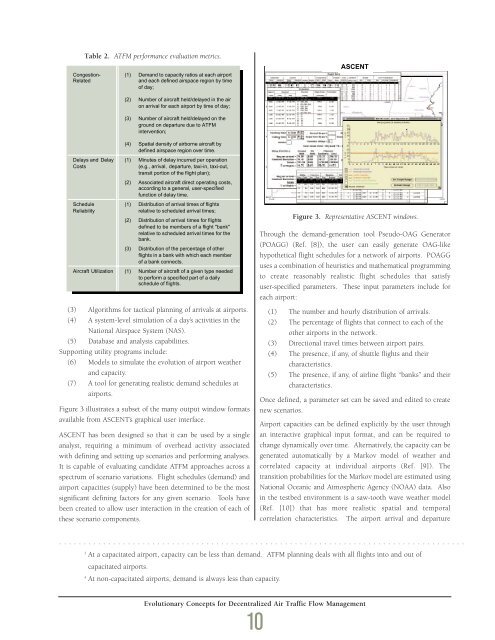1998 - Draper Laboratory
1998 - Draper Laboratory
1998 - Draper Laboratory
- No tags were found...
You also want an ePaper? Increase the reach of your titles
YUMPU automatically turns print PDFs into web optimized ePapers that Google loves.
Table 2. ATFM performance evaluation metrics.ATFM ASCENTSimulation TestbedFigure 3. Representative ASCENT windows.(3) Algorithms for tactical planning of arrivals at airports.(4) A system-level simulation of a day’s activities in theNational Airspace System (NAS).(5) Database and analysis capabilities.Supporting utility programs include:(6) Models to simulate the evolution of airport weatherand capacity.(7) A tool for generating realistic demand schedules atairports.Figure 3 illustrates a subset of the many output window formatsavailable from ASCENT’s graphical user interface.ASCENT has been designed so that it can be used by a singleanalyst, requiring a minimum of overhead activity associatedwith defining and setting up scenarios and performing analyses.It is capable of evaluating candidate ATFM approaches across aspectrum of scenario variations. Flight schedules (demand) andairport capacities (supply) have been determined to be the mostsignificant defining factors for any given scenario. Tools havebeen created to allow user interaction in the creation of each ofthese scenario components.Through the demand-generation tool Pseudo-OAG Generator(POAGG) (Ref. [8]), the user can easily generate OAG-likehypothetical flight schedules for a network of airports. POAGGuses a combination of heuristics and mathematical programmingto create reasonably realistic flight schedules that satisfyuser-specified parameters. These input parameters include foreach airport:(1) The number and hourly distribution of arrivals.(2) The percentage of flights that connect to each of theother airports in the network.(3) Directional travel times between airport pairs.(4) The presence, if any, of shuttle flights and theircharacteristics.(5) The presence, if any, of airline flight “banks” and theircharacteristics.Once defined, a parameter set can be saved and edited to createnew scenarios.Airport capacities can be defined explicitly by the user throughan interactive graphical input format, and can be required tochange dynamically over time. Alternatively, the capacity can begenerated automatically by a Markov model of weather andcorrelated capacity at individual airports (Ref. [9]). Thetransition probabilities for the Markov model are estimated usingNational Oceanic and Atmospheric Agency (NOAA) data. Alsoin the testbed environment is a saw-tooth wave weather model(Ref. [10]) that has more realistic spatial and temporalcorrelation characteristics. The airport arrival and departure...................................................................................3At a capacitated airport, capacity can be less than demand. ATFM planning deals with all flights into and out ofcapacitated airports.4At non-capacitated airports, demand is always less than capacity.Evolutionary Concepts for Decentralized Air Traffic Flow Management10
















